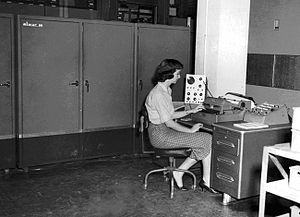
The ALWAC III-E was an early commercial vacuum-tube computer employing a rotating magnetic drum main storage unit,[1] operational in 1955. It weighed about 2,200 pounds (1.1 short tons; 1.00 t).[2]
The invention of the ALWAC III-E is attributed to Axel Wenner-Gren,[3] and the name is derived from Axel Leonard Wenner-Gren Automatic Computer,[4] letter E stands for the E-register (index register).[5][6] The ALWAC III-E contained 132[3]–275[1] vacuum tubes, 5000[3]–5400[1] silicon diodes, and cost $60,000[1]–$80,000.[3][4] Word size was 32 bits + sign + recoverable overflow bit.[3]
Instruction execution times (including average memory access times) were 5.25–5.75 milliseconds for addition and subtraction, and 21.25 ms for multiplication and division.[1]
An ALWAC III-E was installed at the University of British Columbia in March 1957 and remained in service until October 1961. Others were installed at Oregon State University (then College)[4] and Loyola Marymount University (then Loyola University of Los Angeles). An ALWAC III-E was installed by the CIA in September, 1957 in the offices of the Photographic Intelligence Division. Located at Fifth and K streets NW. and given the name Project Automat, the ALWAC was used to analyze pictures taken by U-2 spy planes.
- ^ a b c d e DUBINSKI, GEORGE ANTHONY (June 1960). "SYSTEMS ANALYSIS OF THE ALWAC III-E DIGITAL COMPUTER" (PDF). ScholarsArchive@OSU. Oregon State University. Retrieved 2016-08-11.
- ^ Weik, Martin H. (March 1961). "ALWAC III E". ed-thelen.org. A Third Survey of Domestic Electronic Digital Computing Systems.
- ^ a b c d e "ALWAC III-E". Computer Science - People and Milestones. The University of British Columbia. Archived from the original on 2017-12-20. Retrieved 2016-08-11.
- ^ a b c Törn, Aimo (December 1, 2000). "Wegematic 1000". Early History of Computing in Turku, 1959-1964. Åbo Akademi (University). Retrieved 2016-08-11.
- ^ Impagliazzo, John; Järvi, Timo; Paju, Petri (2009). History of Nordic Computing 2: Second IFIP WG 9.7 Conference, HiNC 2, Turku, Finland, August 21-23, 2007, Revised Selected Papers. Springer Science & Business Media. p. 96. ISBN 9783642037566.
- ^ "4. ALWAC III (Logistics Research, Inc.)". Digital Computer Newsletter. 8 (1): 4. Jan 1956. Archived from the original on April 6, 2019.
